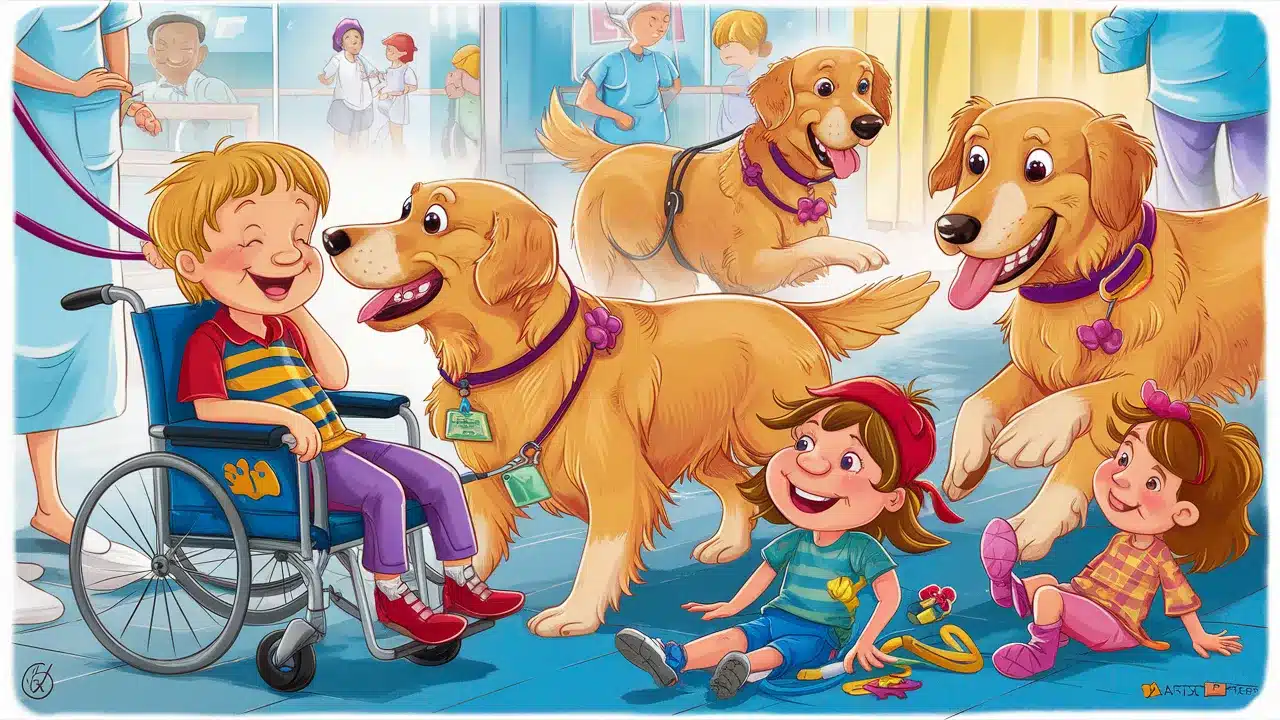Golden Retriever Therapy Dogs in Unlikely Places. Imagine walking into a bustling city library and spotting a calm, gentle Golden Retriever sitting quietly next to a child who’s reading out loud. At first, it might seem unusual, but therapy dogs like these are becoming more common in places you might not expect. Golden Retrievers are making their mark in hospitals, schools, and even airports, providing comfort and companionship to those in need.

Therapy dogs are known for their calming presence and friendly demeanor. Take, for instance, a Golden Retriever visiting a nursing home; the residents light up as the dog enters the room, bringing joy and a sense of calm. Their gentle temperament makes them ideal for these settings, where they can help reduce stress and anxiety.
But why should you care about Golden Retrievers in these unlikely places? These dogs are doing more than just being cute and friendly—they’re making real, positive impacts on people’s lives. Whether assisting learning-disabled children in libraries or comforting travelers at airports, these therapy dogs are proving to be invaluable companions.
The Role of Golden Retriever Therapy Dogs

Golden retriever therapy dogs provide crucial support in healthcare facilities, educational settings, and various community places. Their calming presence and friendly nature help reduce stress, improve moods, and provide a sense of comfort to those in need.
Benefits in Healthcare Facilities
In healthcare settings like hospitals and nursing homes, golden retriever therapy dogs make a significant impact on patients’ well-being. They visit rooms, bringing joy and reducing patients’ anxiety. Their presence alone can make someone smile and feel more relaxed.
Nursing home residents often feel isolated, but a golden retriever’s affectionate nature can brighten their day. For patients undergoing treatment, these therapy dogs help decrease pain perception and lower blood pressure. Visiting dogs create moments of happiness and a distraction from illness.
Therapy dogs are also part of mental health rehabilitation, assisting those with depression or trauma. Studies have shown that interaction with therapy dogs boosts serotonin and dopamine levels, which are chemicals responsible for pleasure and happiness. This positive environment aids in faster recovery.
Therapy Dogs in Educational Settings
In schools and libraries, golden retriever therapy dogs serve as non-judgmental listeners for children learning to read. Kids who struggle with reading may feel more comfortable practicing their skills with a therapy dog by their side.
Libraries often have programs where children read aloud to therapy dogs. This practice boosts their confidence and fluency. The friendly presence of a golden retriever provides a calming effect, making the learning experience enjoyable instead of stressful.
In schools, these dogs also assist students with special needs. They help reduce anxiety and improve social interactions among peers. The bond that forms between the dog and the students encourages positive behavior and emotional development.
Comfort in Community and Public Places
Golden retriever therapy dogs also bring comfort to community and public places like airports, disaster sites, and even workplaces. At airports, they help calm nervous travelers by providing a friendly distraction before their flights.
In disaster aftermaths, therapy dogs offer solace to those affected by trauma. Their gentle demeanor provides comfort and a sense of normalcy during chaotic times. This can be particularly beneficial for children and the elderly who may feel especially displaced.
Workplaces can be stressful environments, and having a golden retriever therapy dog on-site improves morale and reduces tension. Employees benefit from short interactions with these dogs, leading to a more positive and productive work atmosphere.
Understanding Golden Retrievers

Golden Retrievers are beloved for their gentle and friendly nature, combined with impressive physical health characteristics. These traits make them particularly well-suited for therapy work, offering emotional support in various settings.
Temperament and Personality
Golden Retrievers are known for their calm and gentle temperament. They are particularly friendly and patient, making them a perfect fit for therapy roles. Obedience and intelligence are key traits that help them excel in environments where they’re needed to provide comfort. They can adapt to their surroundings and interact with people of all ages, from kids to seniors.
Imagine a Golden Retriever in an elder home, calmly sitting by a senior’s side, offering warmth and companionship. They don’t get easily startled, which is crucial when dealing with unexpected behaviors, like children running towards them. This combination of traits allows them to reduce stress and bring joy to those in need.
Physical and Health Characteristics
Golden Retrievers are known for their strong physical build and overall health. This robust health is vital for therapy dogs, as their job often involves extensive interaction and activity. They have a thick, golden coat that requires regular grooming but adds to their charm and appeal.
These dogs are also quite energetic and need regular exercise, which helps maintain their physical fitness. Health-wise, they are prone to certain issues like hip dysplasia and heart conditions, but with regular health check-ups, these can usually be managed.
Their combination of physical strength and health, paired with their excellent temperament, makes Golden Retrievers ideal candidates for therapy work.
Training and Certification Process

Training and certification are key steps in ensuring that Golden Retrievers can bring joy and comfort as therapy dogs. They require basic obedience skills and advanced training, followed by a formal certification process.
Training Requirements
Training a Golden Retriever to become a therapy dog involves several stages. It starts with basic obedience training where commands like “sit,” “stay,” “come,” and “heel” are essential. These commands can be taught using positive reinforcement techniques such as clicker training and treats.
Once the Golden Retriever masters these basics, the next step is socialization. This involves exposing the dog to various environments, sounds, and people. It’s crucial for therapy dogs to be comfortable in different settings, whether it’s a hospital, school, or nursing home.
In addition to obedience, therapy dogs must be calm and gentle. They should not react negatively to sudden movements or loud noises. Training should also include leash control, where the dog learns to walk calmly beside the handler without pulling.
Achieving Certification
After completing the necessary training, the next step is to achieve certification. Various organizations, like Therapy Dogs International and the AKC Therapy Dog Program, offer certification for therapy dogs.
To get certified, the dog and handler must pass an evaluation. This test assesses the dog’s behavior, obedience, and ability to interact with people in different scenarios. For instance, the dog might be asked to demonstrate its ability to stay calm while being petted by strangers.
Once passed, the therapy dog is officially certified and registered. This certification usually needs to be renewed periodically to ensure the dog maintains its training and behavior standards. Certified therapy dogs can then participate in various therapy dog programs, bringing joy and comfort to those in need.
Regulations and Legal Considerations

Golden Retrievers, like all therapy dogs, must adhere to specific regulations. It’s essential to understand the differences between service dogs and therapy dogs, as their roles and rights vary significantly. Key laws like the Fair Housing Act also impact what access these dogs have.
Service Animals vs Therapy Dogs
Service animals and therapy dogs often get confused, but there are crucial differences. Service dogs are trained to perform specific tasks for individuals with disabilities. They have broad access rights, including public places like restaurants and stores.
In contrast, therapy dogs provide emotional support and comfort. They visit places like hospitals and schools but must get permission beforehand because they don’t have the same access rights as service dogs. The roles they play are equally important, but the legal distinctions are significant.
Laws and Rights
The Fair Housing Act ensures that people with disabilities can live with their service animals even in housing that has a “no pets” policy. Therapy dogs don’t have this legal protection. This distinction can affect where these dogs can accompany their handlers.
Insurance is another important aspect. While service dogs often have legal protections that might simplify insurance concerns, therapy dogs’ handlers need to check their policies to ensure coverage in case of incidents. It’s crucial to understand that the legal landscape differs greatly based on the purpose and training of the dog, highlighting the importance of knowing your rights and responsibilities. For more details, check out the Animal Humane Society on therapy dog training.
Selecting and Preparing a Therapy Dog

Choosing and preparing a golden retriever as a therapy dog involves selecting dogs with the right temperament and ensuring they are well-socialized and trained. Key steps include criteria for selecting a therapy dog and the initial steps in their training and socialization.
Criteria for Selecting a Therapy Dog
A therapy dog must have a gentle temperament and be comfortable around people of all ages and abilities. Golden retrievers are ideal due to their naturally friendly and patient nature. Dogs should be at least one year old to ensure they are mature enough for the duties required.
It’s important to evaluate the dog’s reaction to various stimuli. They should remain calm when faced with noisy environments or sudden movements, such as kids running up to them. An essential trait is their ability to tolerate being petted and hugged by strangers without becoming anxious or aggressive.
Table of Characteristics:
| Characteristic | Requirement |
|---|---|
| Age | At least one year old |
| Temperament | Calm and gentle |
| Comfort with strangers | High |
| Response to stimuli | Calm and tolerant |
Initial Steps and Socialization
Socializing the dog is the first step in preparing for therapy work. This involves exposing the dog to various people, places, and situations.
Regular visits to parks, busy streets, and other public places help the dog get used to different sights, sounds, and smells.
Training should include basic obedience commands like “sit,” “stay,” and “leave it.” Obtaining the AKC Canine Good Citizen title is highly recommended, as it signifies that the dog has mastered essential behaviors needed for therapy work.
List of Training Commands:
- Sit
- Stay
- Leave it
Ensuring the dog can handle different surfaces, objects, and environments is crucial.
Positive reinforcement techniques, such as treats and praise, make training more effective and enjoyable for the dog.
The Bond Between Therapy Dogs and Handlers

The connection between therapy dogs and their handlers is built on trust and teamwork. This bond helps both the dog and the handler better assist those in need.
Building a Trusting Relationship
Creating a trusting relationship between a therapy dog and its handler is essential.
Trust forms through daily interactions and experiences. When the handler shows care and understanding, the dog feels secure and responds positively.
This mutual trust allows the dog to perform its duties effectively, knowing it can rely on its handler.
Handlers often bond with their dogs through activities like play, grooming, and simple, everyday tasks. These moments help the dog associate positive feelings with the handler.
Additionally, consistency plays a crucial role. Dogs rely on routine and predictability, which makes them feel more comfortable and secure.
Training Together as a Team
Training is a significant part of forming a strong bond. When therapy dogs and their handlers train together, they learn to work as a unit.
This training not only includes commands and tasks but also focuses on understanding each other’s cues and comfort levels.
Integrated training sessions help the dog and handler get in sync.
Handlers must be patient and consistent, guiding their dogs with positive reinforcement. This builds confidence in the dog and reinforces the bond between them.
Commitment is another vital component. Handlers must dedicate time and energy to train their dogs, ensuring that training is ongoing and repetitious.
This persistence pays off as the dog becomes more skilled and responsive.
Through training, the handler learns to read the dog’s body language and emotional state. This connection is crucial for providing the best support to those they help. For more insights on training therapy dogs, refer to training your dog to be a therapy dog.
Golden Retrievers Making an Impact
Golden Retrievers are transforming lives through their roles as therapy dogs. Their friendly nature and dedication create meaningful experiences, enhance community bonds, and garner significant media attention.
Success Stories and Testimonials
Golden Retriever therapy dogs have brought joy and comfort to many people.
In nursing homes, they help seniors stay active and improve their mood. Many residents eagerly await visits from these friendly dogs, who provide much-needed companionship.
For instance, one senior named Alice said her weekly visits from a Golden Retriever named Buddy made her feel alive again.
Children in hospitals also benefit from these dogs, finding solace and distraction during stressful treatments.
For families dealing with autism, Golden Retrievers often become trusted friends, reducing anxiety and bridging social gaps.
Media Presence and Awareness
Golden Retrievers are not just loved in person; they shine in the media too.
Stories of their contributions appear regularly on news platforms and social media.
Videos of Golden Retrievers comforting people go viral, spreading awareness of their positive impact.
Campaigns celebrating these dogs often feature heartwarming stories that draw attention to their roles in therapy.
Influencers and celebrities share their experiences with Golden Retriever therapy dogs, further raising their profile.
This widespread media presence helps build community support and encourages more people to consider the benefits of therapy dogs.
Through these efforts, Golden Retrievers continue to inspire and connect with a broad audience.
Engaging with Therapy Dogs
Golden Retrievers, often used as therapy dogs, offer emotional support and engage communities in meaningful ways. These friendly, calm dogs interact through various activities and educational programs, impacting lives significantly.
Interactions and Activities
Therapy dogs visit many places like libraries, hospitals, and schools.
At these locations, they help foster emotional connections.
In hospitals and hospices, therapy dogs comfort patients through physical touch and presence. Patients often light up, sharing stories or just enjoying the snuggles.
In libraries, children read to therapy dogs.
This helps kids improve their reading skills without feeling judged, boosting their confidence.
Community centers might host therapy dog events that allow more people to experience their calming influence.
These activities build strong bonds and provide stress relief, showing the broad impact therapy dogs can make.
Educational Programs and Outreach
Therapy dogs also play a role in education. Schools might bring in these trained dogs for special programs. They teach students about empathy and proper animal care.
Children learn not just to read but also to interact kindly with animals. This can be an important part of their emotional growth.
In some communities, therapy dogs visit shelters, supporting those going through hard times. Programs often extend to public events. Here, people can meet therapy dogs and learn about their work.
These opportunities highlight the value of therapy dogs beyond just emotional support. They become part of educational outreach, spreading awareness and compassion.
Engagement with therapy dogs, like Golden Retrievers, brings joy and learning to various community settings. From patient care to educational outreach, these dogs make a significant, positive impact.









